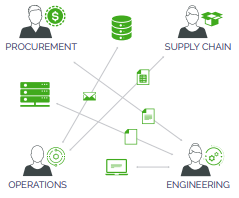As the nature of product development continues to evolve, manufacturers must keep pace with technology to deliver innovative, high-quality products fast. There are many tools and solutions used by design and manufacturing teams, including mechanical CAD (mCAD), electrical design automation (EDA/eCAD), product data management (PDM), and enterprise resource planning (ERP). These solutions all play roles in the NPD and new product introduction (NPI) process, but none were designed to aggregate the entire product design comprised of electrical, mechanical, and software components, or the associated suppliers, drawings, specifications, and files. Furthermore, these types of solutions were not created to speed engineering change processes with secure, real-time collaboration among distributed teams and supply chains.

mCAD
Mechanical engineers take product requirements and transform them into effective designs using mCAD software. The design output is managed in drawings, 3D models, and other files. The assembly can also include the bill of materials (BOM), but it’s the BOM for mechanical design only.
EDA/eCAD
For products with electrical components, electrical engineers create designs with EDA tools. These designs include schematics, Gerber files, netlists, and electrical BOMs. Ensuring interoperability between mechanical and electronic assemblies is a complex and time-consuming endeavor.
PDM
PDM tools are often employed to manage mechanical designs within a shared engineering workgroup. PDM provides a data repository for mechanical designs by allowing multiple engineers to collaborate, share files, control the checkout and check-in processes, and eliminate overwriting any version of the design accidentally. PDM tools are primarily used by mechanical engineering teams to coordinate efforts with each other during the design phase.
PLM
PLM is designed to speed the entire concept-to-production process by bringing the engineering designs together and sharing these beyond the individual engineering workgroups. As the rest of the product team members get involved—from quality to manufacturing to procurement—everyone can review the entire design and provide their input before releasing the final product and starting the planning and product process. The innovative designs, in the form of 3D models, drawings, specifications, and schematics, will be married together in PLM and transformed into products after many iterative design changes have been made. Each member of the product team will do their part to make sure cost-effective and compliant components can be sourced, built, and shipped to meet the customer demand. PLM will manage all items, assemblies (BOMs), engineering change orders (ECOs), approved manufacturers and vendors lists (AML/ AVL), and compliance status. For a product to be manufactured at a low cost, on time, and with high quality, mechanical design teams must collaborate with electrical and software design teams, component suppliers, and even contract manufacturers. Everyone involved in designing, testing, and producing the final product must be able to work together in a single system. mCAD, PDM, and other design tools are not cloud-based or intended to be used by non-technical teams outside of engineering.













 Spreadsheets, CAD, ERP, or point solutions are used by engineering and production teams. Companies that rely on patch-quilt solutions, ranging from spreadsheets to documents to social collaboration or file storage apps, find themselves with too many silos that are disconnected from a controlled product record.
Spreadsheets, CAD, ERP, or point solutions are used by engineering and production teams. Companies that rely on patch-quilt solutions, ranging from spreadsheets to documents to social collaboration or file storage apps, find themselves with too many silos that are disconnected from a controlled product record.